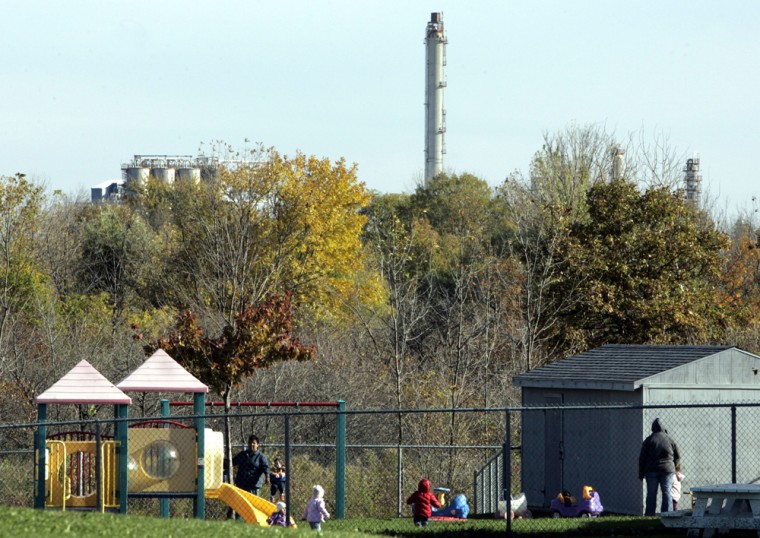Growing up with smokestacks on the horizon, Ada Lockridge never thought much about the pollution that came out of them.
She never worried about the oil slicks in Talfourd Creek, the acrid odors that wafted in on the shifting winds or even the air-raid siren behind her house whose shrill wail meant “go inside and shut the windows.”
Now Lockridge worries all the time.
A budding environmental activist, she recently made a simple but shocking discovery: There are two girls born in her small community for every boy. A sex ratio so out of whack, say scientific experts who helped her reveal the imbalance, almost certainly indicates serious environmental contamination by one or more harmful chemicals.
The question: Which ones? And another, even more pressing question: What else are these pollutants doing to the 850 members of this Chippewa community?
Lockridge and her neighbors live just across the U.S.-Canada border from Port Huron, Mich., on the Aamjiwnaang First Nation Reserve. For nearly half a century, their land has been almost completely surrounded by Canada’s largest concentration of petrochemical manufacturing.
Much of their original reserve, founded in 1827, was sold out from under them via questionable land deals in the 1960s. It is now occupied by pipelines, factories and row upon row of petroleum storage tanks.
The area is so dominated by the industry that it is referred to on maps and in local parlance as “Chemical Valley.”
About two years ago, Suncor Energy — which already operates a refinery and petrochemical plant next to the Aamjiwnaang reserve — proposed adding another factory to the mix, an ethanol plant to be built on one of the few undeveloped parcels adjoining the community’s property.
Biologist asks about boys
Lockridge and other members of the band joined to oppose the plant. They asked biologist Michael Gilbertson to look at a binder full of technical information about air, water and soil contamination on the reserve.
In a conference call, he reported that the data showed elevated levels of dioxin, PCBs, pesticides and heavy metals including arsenic, cadmium, lead and mercury.

Almost as an afterthought, he asked a question: Had anybody noticed a difference in the number of girls and boys in the community?
At the other end of the line, the Aamjiwnaang and their allies were suddenly abuzz.
“All of a sudden everybody in that room started talking,” said Margaret Keith, a staffer for the Occupational Health Clinic for Ontario Workers, a public health agency.
Somebody pointed out that the reserve had fielded three girls’ baseball teams in a recent year and only one boys’ team. Lockridge thought about herself and her two sisters, with eight daughters among them and only one son.
Sex ratio as chemical indicator
The question was not as offhand as it seemed. “I had been interested in sex ratio as an indicator — a very sensitive indicator of effects going on as a result of exposure to chemicals,” Gilbertson said in a recent interview.
Gilbertson explained that certain pollutants, including many found on the Aamjiwnaang reserve, could interfere with the sex ratio of newborns in a population. Heavy metals have been shown to affect sex ratio by causing the miscarriage of male fetuses. Other pollutants known as endocrine disrupters — including dioxin and PCBs — can wreak all sorts of havoc by interfering with the hormones that determine whether a couple will have a boy or a girl.
If some pollutant was skewing the distribution of girls and boys in her family and her community, Ada Lockridge thought, what else could it be doing?
Statistics indicate that one in four Aamjiwnaang children has behavioral or learning disabilities, and that they suffer from asthma at nearly three times the national rate. Four of 10 women on the reserve have had at least one miscarriage or stillbirth.
“I was throwing up thinking about what was in me,” said Lockridge, who is 42. “I cried. And then I got angry.”
She got a copy of the band membership list, and tallied the number of boys and girls born in each year since 1984. Sure enough, the percentage of boys started dropping below 50 percent around 1993. It is now approaching 30 percent, with no sign of leveling off.
The finding was significant enough to warrant a paper in Environmental Health Perspectives, a well-regarded scientific journal. Lockridge, who has worked as a home health aide and carpenter’s assistant, was listed as an author.
No peace at cemetery
On a recent autumn day, Lockridge stood in the Aamjiwnaang band’s cemetery. The burial ground occupies a gently sloping patch of ground sandwiched between a petroleum storage tank farm and a low cinder-block building with half a dozen pipelines running through it.
It is hardly a place where anyone could rest in peace. The building emits a constant, deafening roar that sounds like a wood-chipper buzzing through logs one after the next. It is so loud that funeral ceremonies have to be shouted.
One of the oldest headstones in the cemetery belongs to Lockridge’s great-grandfather, who died at least 50 years before Suncor Energy erected a giant flare tower not 100 yards away.
Lockridge was talking about how security guards watch and occasionally film her as she pulls weeds around her family’s plots. Suddenly she stopped short.
“Okay,” she said. “You getting that smell right now?”
Traveling around the 3,250-acre Aamjiwnaang reserve is a stimulating olfactory experience. There are tangy smells, sweet smells and acrid odors that sting the nose. There is the tarry scent of unrefined petroleum, and the rotten-eggs stench of sulfur.
There’s also a “fart” smell, Lockridge said, a “stink-feet” smell and something that “smells like what the dentist puts on a Q-Tip before he gives you the needle.”
Whenever she detects a distinctive odor somewhere on the reserve, she makes a note of it and records it on a calendar at home.
Change in 1990s?
Lockridge’s discovery of a sudden shift in sex ratio suggests a new pollutant came into the Aamjiwnaang’s environment during the early 1990s. And the fact that the decrease is continuing suggests that whatever that pollutant is, it is still around.
So far, nobody recalls anything new coming on the scene during the early ’90s. And the levels of likely suspects such as PCBs and mercury have actually decreased in the past decade.
The sex ratio of newborn babies is normally within a hair’s breadth of 50-50, with slightly more boys born than girls. There are very few documented cases of an imbalance as extreme as the one of the Aamjiwnaang reserve.

During the late 1950s, a severe outbreak of mercury poisoning in Minamata, Japan, caused a decrease in the percentage of male births. Mercury and other heavy metals cause the preferential miscarriage of male fetuses simply because their brains are more vulnerable during development compared to those of females.
Mercury is unlikely to be causing the shortage of boys on the Aamjiwnaang reserve, however. Though levels of the metal are elevated on the reserve, the Aamjiwnaang are exposed to much less mercury today than they were 50 years ago. Back then, poor band members would go to open toxic waste dumps and extract mercury from the soil by adding water to it, then sell the metal on the black market.
The Aamjiwnaang and their scientific advisers believe it is more likely that endocrine disrupters are to blame. Dozens of synthetic organic chemicals can interfere with natural hormones by either interfering with or amplifying their effects. Because hormones are so important to the development and healthy performance of the body’s organs, endocrine disrupters have the potential to cause a wide range of effects, from damage to the brain and sex organs in utero to decreased sperm production and immune suppression in adults. It is even arguable that they could influence sexual behavior and violence.
In her book “Our Stolen Future,” biologist Theo Colborne worries that endocrine disrupters may be responsible for “physical, mental and behavioral disruption in humans that could affect fertility, learning ability, aggression and conceivably even parenting and mating behavior.”
Some researchers have suggested that endocrine disrupters may be responsible for numerous alarming trends — rising rates of testicular and breast cancer, a higher frequency of reproductive tract abnormalities, declining sperm counts and increases in learning disabilities among them.
Similar sex shift in Italian town
In 1976, a dioxin release at a factory in Seveso, Italy, sickened at least 2,000 people. Years later, scientists found that men who were exposed to the highest dioxin levels were more likely to have daughters than sons. Among men who were younger than 19 years old at the time of the accident, the ratio was the same as it is today on the Aamjiwnaang reserve — two-to-one.
At lower doses, the effects of endocrine disrupting chemicals are subtle and have been harder to document.
“Not a lot is known, actually,” said Marc Weisskopf, a research associate at the Harvard School of Public Health.
In a 2003 study, he and several colleagues found that mothers who consumed large amounts of PCB-contaminated fish caught in the Great Lakes were more likely to have girls.
It is extremely difficult to say whether background doses of endocrine disrupters are having any effect on the general population. Scientists in many industrialized countries — including the United States and Canada — have documented a subtle decline in the male-to-female ratio since World War II. But it has been a matter of controversy whether the decrease is due to industrial chemicals or lifestyle factors and medical advances, which can also tinker with the sex ratio.
Sex changes in wildlife
There is little doubt that endocrine-disrupting pollutants are affecting the sexual development of wildlife right where the Aamjiwnaang live. In Lake St. Clair, not 30 miles from their reserve, fish are swimming around with both male and female gonads. The condition, known as intersex, is caused when a young fish that is genetically male is exposed to chemicals such as the fertilizer atrazine, which causes female gonads to develop by acting like the hormone estrogen.
The phenomenon has been documented all over the southern Great Lakes — not just in fish, but in birds and amphibians as well.
The Aamjiwnaang are getting increasingly worried and obsessed about the pollution of their reserve. With every new baby, said Ron Plain, a member of the Aamjiwnaang environment committee, “we have to worry what’s the matter with that child, five years from now, 10 years from now, 20 years from now.”
Some people have suggested that the whole band should simply pick up and leave the reserve for a less contaminated place. But Plain wants to stay and fight.
Petitions and demonstrations against the Suncor ethanol plant eventually convinced the company to choose a location about 10 miles south of the reserve for the new facility. A Suncor spokesman said that community opposition was one of several factors that led to the decision.
Leveraging the future
Now Plain wants to use the band’s veto power over new pipelines crossing the reserve as a bargaining chip: For example, in return for allowing a right-of-way, the Aamjiwnaang would require establishment of a fund to set up a network of air monitoring stations. The money could also be used to clean up hazardous waste sites on the reserve, or other environmental projects.
“The band doesn’t have the money for that type of stuff,” said Plain, who runs his own medical supply company. “If we have a million dollars we can hire some pretty good experts.”
Alan Joseph is not sure he can wait.
He has five children — a boy and four girls. All suffer from asthma; the eldest girl has liver problems.
He used to catch crawfish in Talfourd Creek and fish in the St. Clair River, less than a quarter mile from his house. Now, if he wants to go fishing, he drives 25 miles up the shore of Lake Huron.
“I really want to move,” he said.
